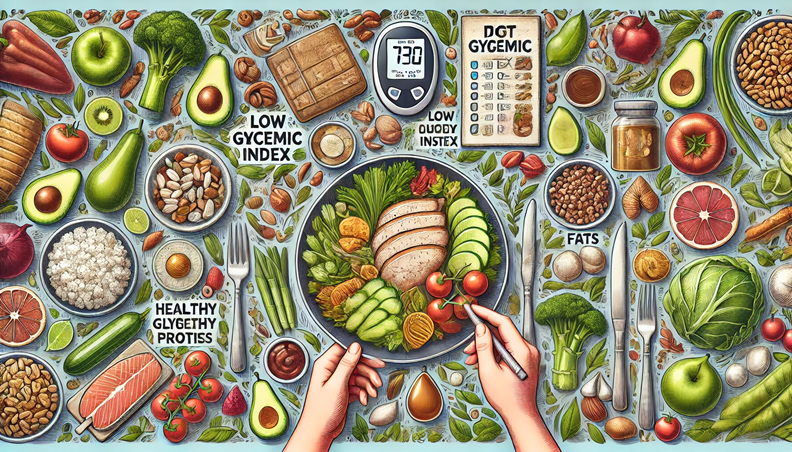How to Manage Diabetes with the Right Food Choices

Managing diabetes requires careful attention to diet. Whether you have type 1 or type 2 diabetes, the foods you eat can directly impact your blood sugar levels, energy, and overall health. But with so much information available, it can be challenging to know which foods are the best for managing diabetes. In this article, we will explore the top foods to prioritize to help you maintain stable blood sugar levels and improve your overall well-being.
Table of Contents
1. Non-Starchy Vegetables
Non-starchy vegetables, such as leafy greens, cucumbers, tomatoes, and peppers, are excellent choices for people with diabetes. These vegetables are low in calories and carbohydrates, meaning they won’t cause significant spikes in blood sugar levels. They’re also packed with fiber, vitamins, and minerals, which support overall health and digestion.
Examples of non-starchy vegetables include:
- Spinach
- Broccoli
- Zucchini
- Cauliflower
- Green beans
Incorporating these into your meals can help you feel full without impacting your glucose levels.
2. Whole Grains
Whole grains, such as oats, brown rice, and quinoa, are a better alternative to refined grains like white bread and white rice. These whole grains are rich in fiber, which helps slow the absorption of sugar in your bloodstream. Fiber also promotes better digestion and helps maintain heart health, a crucial factor for those with diabetes.
Top choices of whole grains include:
- Oats
- Quinoa
- Barley
- Brown rice
- Whole-wheat bread
Swapping refined grains for whole grains is a simple way to help stabilize blood sugar levels.
3. Lean Proteins
Protein plays a crucial role in managing diabetes. It helps with muscle repair and keeps you feeling full longer, reducing the likelihood of overeating or snacking on high-sugar foods. Choosing lean protein sources over fatty cuts of meat can help maintain a balanced diet without excess calories or saturated fats, which can negatively impact heart health.
Good sources of lean protein include:
- Chicken breast
- Turkey
- Fish (especially fatty fish like salmon and mackerel, which are rich in omega-3 fatty acids)
- Tofu
- Legumes (beans, lentils)
Including a source of lean protein in every meal can help you manage hunger and blood sugar levels more effectively.
4. Healthy Fats
Not all fats are bad! In fact, healthy fats are essential for everyone, especially those managing diabetes. Monounsaturated and polyunsaturated fats, found in foods like avocados, olive oil, and nuts, can help improve heart health and provide a slow, steady source of energy.
Examples of healthy fats include:
- Avocados
- Olive oil
- Almonds
- Walnuts
- Flaxseeds
Just be mindful of portion sizes, as fats are calorie-dense. A small handful of nuts or a tablespoon of olive oil is enough to reap the benefits without overdoing the calories.
5. Low-Glycemic Fruits
While fruits contain natural sugars, they can still be part of a healthy diabetes diet when chosen wisely. Focus on low-glycemic fruits, which have less impact on your blood sugar levels. These fruits are rich in fiber, vitamins, and antioxidants, making them a nutritious and satisfying snack or dessert option.
Great low-glycemic fruits include:
- Berries (blueberries, strawberries, raspberries)
- Apples
- Pears
- Oranges
- Peaches
Remember to consume fruit in moderation and pair it with a source of protein or healthy fat to minimize spikes in blood sugar.
6. Dairy Alternatives or Low-Fat Dairy
Dairy can be a part of a balanced diet, but for those managing diabetes, it’s essential to opt for low-fat versions or dairy alternatives that don’t contain added sugars. Dairy is a source of calcium and protein, but full-fat dairy can be high in saturated fat, which may increase the risk of heart disease—a common concern for diabetics.
Consider these options:
- Low-fat yogurt (plain or Greek yogurt)
- Skim or 1% milk
- Unsweetened almond milk
- Low-fat cottage cheese
When choosing dairy or alternatives, always check for added sugars in products like flavored yogurts.
7. Legumes and Beans
Legumes, such as beans, lentils, and chickpeas, are nutrient-dense foods that provide a combination of complex carbohydrates, fiber, and protein. They are low on the glycemic index, which means they have a minimal impact on blood sugar levels. Including legumes in your meals can help you stay full longer while providing sustained energy.
Examples of legumes include:
- Black beans
- Lentils
- Chickpeas
- Kidney beans
- Split peas
These foods can be used in salads, soups, or as a protein source in meals.
Conclusion
Managing diabetes through diet doesn’t mean you have to feel restricted. By prioritizing whole, nutrient-dense foods that are low in refined sugars and unhealthy fats, you can keep your blood sugar levels stable and enjoy a variety of delicious meals. Non-starchy vegetables, whole grains, lean proteins, healthy fats, and low-glycemic fruits should form the foundation of your eating plan. Always consult with a healthcare professional or dietitian to create a personalized eating plan that suits your needs.






